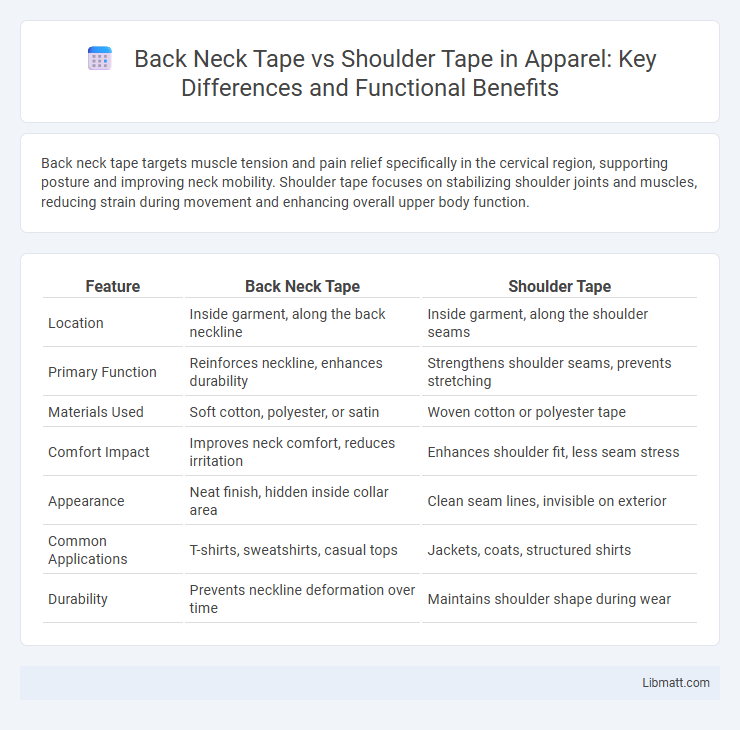Back neck tape targets muscle tension and pain relief specifically in the cervical region, supporting posture and improving neck mobility. Shoulder tape focuses on stabilizing shoulder joints and muscles, reducing strain during movement and enhancing overall upper body function.
Table of Comparison
| Feature | Back Neck Tape | Shoulder Tape |
|---|---|---|
| Location | Inside garment, along the back neckline | Inside garment, along the shoulder seams |
| Primary Function | Reinforces neckline, enhances durability | Strengthens shoulder seams, prevents stretching |
| Materials Used | Soft cotton, polyester, or satin | Woven cotton or polyester tape |
| Comfort Impact | Improves neck comfort, reduces irritation | Enhances shoulder fit, less seam stress |
| Appearance | Neat finish, hidden inside collar area | Clean seam lines, invisible on exterior |
| Common Applications | T-shirts, sweatshirts, casual tops | Jackets, coats, structured shirts |
| Durability | Prevents neckline deformation over time | Maintains shoulder shape during wear |
Introduction to Back Neck Tape and Shoulder Tape
Back neck tape and shoulder tape are specialized kinesiology tapes designed to support distinct muscle groups and joints, facilitating pain relief and enhanced mobility. Back neck tape primarily targets the cervical spine and upper trapezius muscles, alleviating tension and improving posture. Shoulder tape focuses on stabilizing the shoulder joint and deltoid muscles, aiding in the recovery of rotator cuff injuries and reducing inflammation.
Key Differences Between Back Neck Tape and Shoulder Tape
Back neck tape is strategically applied along the cervical spine to relieve neck tension and improve posture, while shoulder tape targets the deltoid and trapezius muscles to support shoulder mobility and reduce strain. The materials used for both tapes are similar, but back neck tape is typically narrower to accommodate the spine's contours, whereas shoulder tape is broader for muscle coverage. Understanding these key differences helps you choose the appropriate taping technique to address specific musculoskeletal issues effectively.
Common Uses for Back Neck Tape
Back neck tape is commonly used to relieve tension and improve posture by supporting the cervical spine and reducing strain in the upper trapezius muscles. It provides targeted pain relief for conditions like neck stiffness, whiplash, and cervical spondylosis by promoting better blood circulation and reducing muscle fatigue. Unlike shoulder tape, which targets shoulder joint stability and rotator cuff support, back neck tape specifically addresses discomfort and mobility restriction in the neck and upper back regions.
Primary Applications of Shoulder Tape
Shoulder tape is primarily used to stabilize the shoulder joint during sports activities and physical therapy, enhancing muscle support and reducing strain on the rotator cuff and deltoid muscles. It is frequently applied to manage shoulder instability, improve posture, and prevent injuries in athletes performing overhead motions such as swimming, baseball, and volleyball. Unlike back neck tape, which targets cervical alignment and neck pain relief, shoulder tape focuses on supporting joint mobility and muscle recovery in the shoulder region.
Materials and Design Features
Back neck tape typically features flexible, hypoallergenic cotton or synthetic blends designed to contour the cervical spine for support and pain relief. Shoulder tape often incorporates stronger, moisture-wicking materials with reinforced edges to endure dynamic movements and provide joint stabilization. Both types use adhesive technologies that balance skin breathability with secure attachment during physical activity.
Benefits of Using Back Neck Tape
Back neck tape offers targeted support to the cervical spine, helping to alleviate neck pain and improve posture by stabilizing muscles and reducing strain. It enhances blood circulation in the upper back and neck area, promoting faster recovery from muscle fatigue and tension. Unlike shoulder tape, back neck tape specifically addresses mobility issues and discomfort related to the neck region, making it ideal for individuals with neck stiffness or cervical spine injuries.
Advantages of Shoulder Tape for Injuries
Shoulder tape offers superior support for rotator cuff strains, preventing excessive movement and enhancing muscle stabilization. Its wider coverage compared to back neck tape promotes better posture correction and reduces tension across the shoulder girdle, accelerating injury recovery. You benefit from improved joint alignment and pain relief, which facilitates faster rehabilitation during shoulder injuries.
Choosing the Right Tape for Your Needs
Back neck tape offers targeted support for neck muscles, reducing strain and improving posture during prolonged activities. Shoulder tape provides broader coverage, stabilizing shoulder joints and alleviating pain from rotator cuff injuries or muscle imbalances. Selecting the appropriate tape depends on the specific area of discomfort and desired mobility support, with kinesiology tape brands like KT Tape or RockTape offering specialized options for both regions.
Application Techniques and Tips
Back neck tape is applied vertically along the spine from the base of the skull to the upper back, providing support to neck muscles and improving posture. Shoulder tape typically involves horizontal or diagonal strips across the shoulder joint to stabilize muscles and reduce strain during movement. To maximize effectiveness, ensure your skin is clean and dry before application, avoid overstretching the tape, and smooth it firmly while activating the adhesive for secure, long-lasting support tailored to Your specific muscle needs.
Frequently Asked Questions About Taping
Back neck tape targets muscle strain and posture correction in the cervical spine area, while shoulder tape supports joint stability and pain relief in the shoulder girdle. FAQs often address tape application techniques, duration of use, and skin sensitivity concerns for both types. Users frequently ask about the effectiveness of kinesiology tape in relieving tension and improving mobility in targeted body regions.
Back neck tape vs shoulder tape Infographic

 libmatt.com
libmatt.com